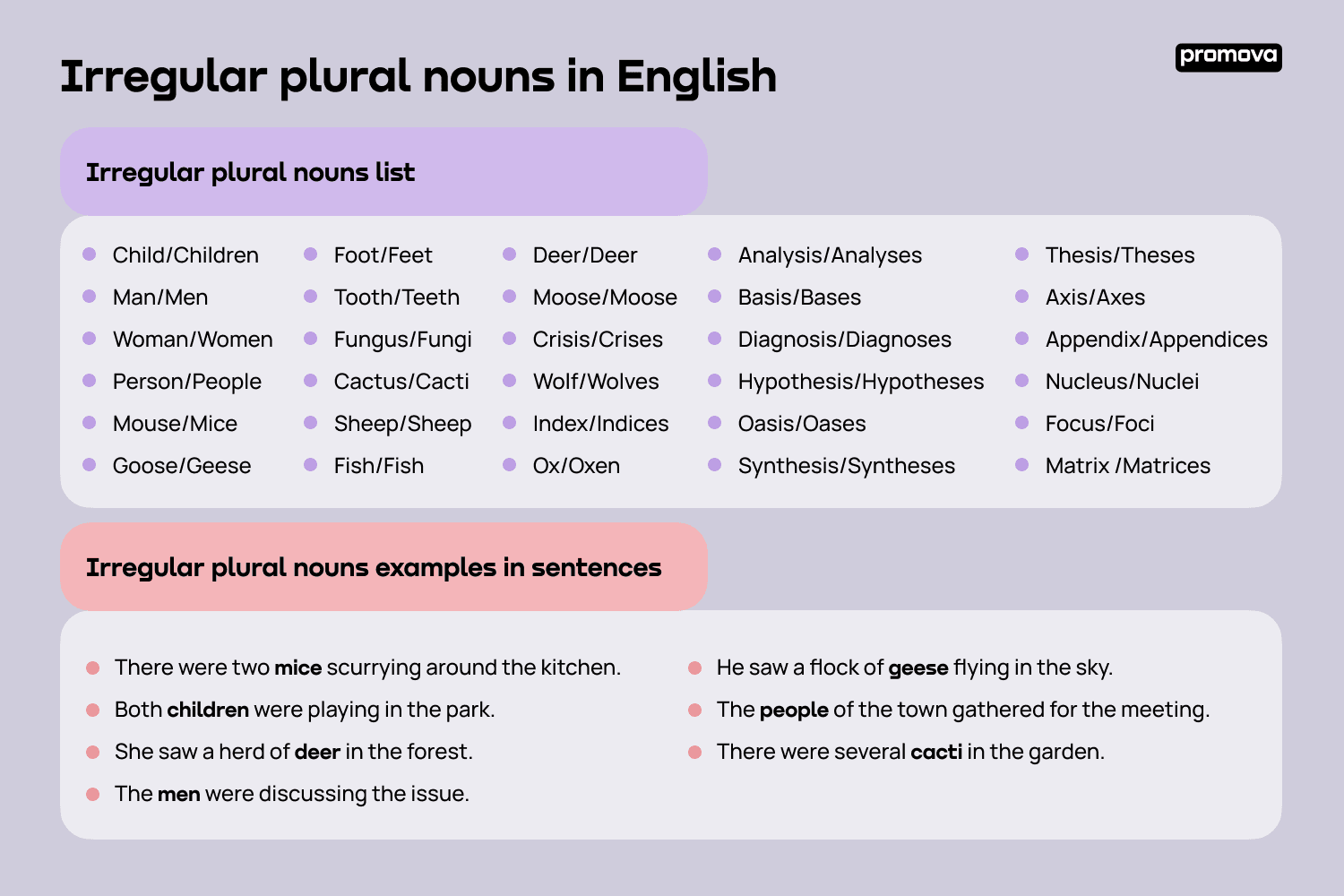Irregular plural nouns in English
Contents
English is full of surprises when it comes to making words plural. While many nouns just add an -s (like "cats" or "dogs"), some change completely – think "mouse" turning into "mice" or "child" into "children." This article takes a closer look at irregular plural nouns and explains why they don't follow the usual rules.
What is an irregular plural noun?
An irregular plural noun is a noun that does not follow the standard rule of adding "-s" or "-es" to become plural. Instead, it changes spelling in unique ways or stays the same.
We use plural forms of the words when we need to specify that we're talking about more than one person, animal, thing, or idea. In most cases, creating plural forms is simple – you only need to add -s or -es ending to the word. This way, one cat turns into multiple cats, one bus – in several buses, etc. These nouns have regular plural forms. But what are irregular plural nouns?
Irregular plural nouns change in different ways, sometimes quite drastically. For instance, instead of "mouses," the word "mouse" changes to "mice," "man" becomes "men," and "tooth" turns into "teeth."
These and other irregular plural noun examples have mostly developed over time due to the historical influences on the English language. Many plural irregular forms come from older linguistic patterns or borrowings from other languages, so they don't always fit neatly into modern rules. But how can you identify them?
How to recognize irregular plural forms
Most plural irregular nouns can be divided into several groups, depending on how they're formed. Take a look at the most common examples of irregular plural nouns and how they are formed.
- Vowel changes
Some irregular plural words are formed by changing one single vowel. For example:
man → men;
foot → feet;
goose → geese.
- Complete changes
In some cases, an irregular plural noun can significantly differ from its singular form. For example:
mouse → mice;
child → children;
louse → lice.
- No changes at all
There is also a list of irregular plural nouns that, unlike the previous two, don't have any changes. For example:
sheep → sheep;
deer → deer;
fish → fish.
- Ending changes
Some irregular plural form examples are created by changing the ending of the word. These are mostly nouns that have Greek or Latin roots. For example:
cactus → cacti;
stimulus → stimuli;
fungus → fungi.

Irregular plural nouns list
Now that you're familiar with some of the most common irregular plural examples, it's time to solidify this knowledge. Here is a list of the most used English nouns that have unusual plural forms:
- child → children
- man → men
- woman → women
- person → people
- mouse → mice
- goose → geese
- foot → feet
- tooth → teeth
- fungus → fungi
- cactus → cacti
- sheep → sheep
- fish → fish
- deer → deer
- moose → moose
- crisis → crises
- index → indices
- ox → oxen
- analysis → analyses
- basis → bases
- axis → axes
- appendix → appendices
- nucleus → nuclei
- focus → foci
- matrix → matrices
Take a look at this irregular plurals list again to help you memorize words better and understand them when used in sentences.
1
Irregular plural nouns examples in sentences
So, how do you use words from the abovementioned irregular plural list in sentences? Here are irregular plural nouns sentences to help you memorize them in context:
- There were two mice scurrying around the kitchen.
- Both children were playing in the park.
- She saw a herd of deer in the forest.
- The men were discussing the issue.
- He saw a flock of geese flying in the sky.
- The people of the town gathered for the meeting.
- There were several cacti in the garden.
Rules of irregular plurals
Although there are no definite rules about the irregular noun plural forms, some things are important to keep in mind.
- Memorization is essential. Since there isn't a one-size-fits-all formula for creating them, focus on memorizing each individually.
- Context matters. Some irregular plural nouns rules are context-specific. For instance, while "fish" is often used for multiple individuals of the same species, "fishes" can be used when referring to different species of fish.
- Remember the subject-verb agreement. Ensure that your verbs and pronouns match the number of the noun you're using. For example, even though "children" is an irregular plural, it still requires plural verbs (e.g., "The children are playing").
And don't worry! Once you remember enough words from the irregular plural noun list, you can recognize them in sentences and use them correctly.
Common mistakes
Making mistakes is one of the best ways to learn and improve. That's why when it comes to irregular plural nouns, it is essential to know some common pitfalls to avoid them. The most widespread ones include:
- Treating irregular plurals like regular ones. Creating them by adding -s and -es instead of using proper forms.
- Mixing up plural and singular forms. For example, using the word "woman" when the context calls for "women."
- Misapplication of patterns. Assuming all vowel changes or ending modifications apply universally may lead to errors. Not every word that changes a vowel in its plural follows the same rule, so it's important to learn each case individually.
These are the most common mistakes that can appear when learning irregular plural nouns. Pay close attention to them!
Summary
Today, we have discussed irregular plural nouns in English in detail, providing ways of forming them and some common mistakes to avoid during learning. And while irregular plurals might sound confusing at first, with enough practice, you will soon be able to use them without any problems. Good luck on your learning journey!



Comments